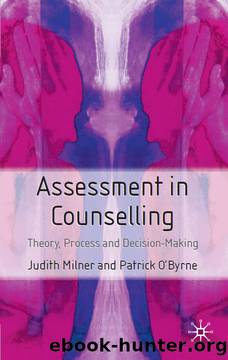Assessment in Counselling by Milner Judith; O'Byrne Patrick

Author:Milner, Judith; O'Byrne, Patrick
Language: eng
Format: epub
Publisher: Palgrave Macmillan
Implications of CBT and RET for assessment
Suitability
Counsellors who use this approach often give people a pre-meeting questionnaire that may include various questions from the Depression Inventory or the Dysfunctional Attitude Scale (DAS). At the assessment meeting/s, the replies may be discussed, mainly with a view to establishing whether the person can identify emotions and consider that there is a psychological component to their problem. As most cognitively-oriented counsellors seem to be in the NHS, risk assessments are done routinely. Goals are discussed and agreed, and the person has to be capable of seeing that they will have to do the hard work of personal change. The counsellor asks him/herself âCan they see that the problem is linked to beliefs and thought processes and not something that can be more easily removed by pain-killers, for example?â Clients need to accept the model and be motivated enough to carry out the homework tasks and not have too low a tolerance of frustration, or too low a sense of personal responsibility for their problems. Many CBT counsellors would not accept severely psychotic people. One respondent put it as âcan the person psychologically construe?â
Formulation
In this approach, gaining understanding of the clientâs emotional responses and cognitive behaviours is essential. This understanding is best gained in a flexible collaborative way, seeking the clientâs own understanding of their problem and the implications of their views. Often the counsellor will explore in considerable detail specific situations where the problem presents itself. The client is asked what was going through their mind, what they were saying to themselves before and during the incident, what thoughts feelings and behaviours are maintaining the problem. They can be invited to try out less self-defeating beliefs or assumptions (to talk them out seems to be more effective than writing them) and see what difference this can make until they find what best promotes the desired change. This is like testing a new cognitive map of life. Some counsellors use the term blocks to refer to the thoughts and behaviours that keep the problem from being solved. Tests such as the DAS may be employed as an additional guide and baseline. The counsellor listens for distorted or unhelpful thoughts, like those listed above, and for the addictions mentioned earlier. They may discuss where these ideas came from â perhaps early experiences. As one of our respondents said, âEarly experience. I look at this. Cognitive behaviour therapists need to understand how the person got into the predicament ... what we donât do is interpret that for themâ. The counsellor would explore the impact of their way of thinking on their life. Finally, a baseline is established concerning the severity and frequency of the problem so that progress can be easily noticed and used to reinforce the work.
Ongoing assessment
Reviews are usually built in to the plan to check on progress and whether the most useful ideas are being used in the work. Ending is mainly planned by discussion with the client.
Download
This site does not store any files on its server. We only index and link to content provided by other sites. Please contact the content providers to delete copyright contents if any and email us, we'll remove relevant links or contents immediately.
| Administration & Medicine Economics | Allied Health Professions |
| Basic Sciences | Dentistry |
| History | Medical Informatics |
| Medicine | Nursing |
| Pharmacology | Psychology |
| Research | Veterinary Medicine |
Bioenergetica by Alexander Lowen(1424)
The Child in You by Stefanie Stahl(1201)
No Bad Parts by Richard C. Schwartz(1170)
Noise: A Flaw in Human Judgment by Sunstein Cass R. & Sibony Olivier & Kahneman Daniel(1153)
The Data Detective by Tim Harford(1099)
Chatter by Ethan Kross(1023)
The Science of Rapid Skill Acquisition by Peter Hollins(870)
The Quantum Psychiatrist: From Zero to Zen Using Evidence-Based Solutions Beyond Medication and Therapy by Biswas Dona(832)
Freedom by Sebastian Junger(813)
The Montessori Baby by Simone Davies(788)
Maps of Meaning: The Architecture of Belief by Jordan B. Peterson(706)
The Science of Self-Learning: How to Teach Yourself Anything, Learn More in Less Time, and Direct Your Own Education (Learning how to Learn Book 1) by Peter Hollins(689)
Evolution Gone Wrong: The Curious Reasons Why Our Bodies Work by Alex Bezzerides(672)
Sadomasochism and the BDSM Community in the United States by Stephen K. Stein(652)
Anxiety For Dummies by Charles H. Elliott & Laura L. Smith(635)
Why Sex Doesn't Matter by Olivia Fane(627)
Disconnected by thomas Kersting(621)
Jung - The Key Ideas: Teach Yourself (TY Philosophy) by Ruth Snowden(595)
The Mechanics of Passions: Brain, Behaviour, and Society by Alain Ehrenberg(590)
